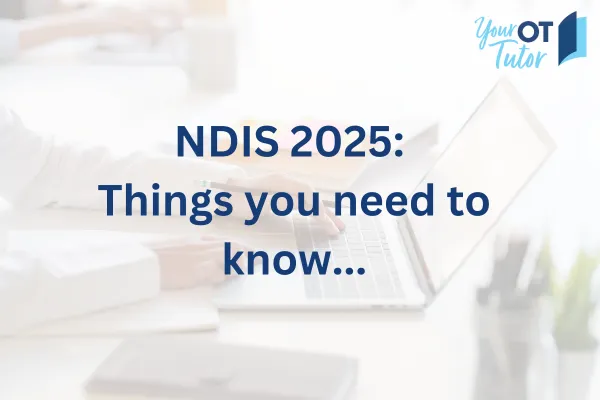THE YOUR OT TUTOR BLOG
Articles on important topics for occupational therapists...


NDIS 2025: 10 things you need to know...
It’s been a tough start to 2025 for anyone working in the NDIS. That’s probably an understatement. It’s hard for businesses, stressful for clinicians and in many cases, harmful for participants.
Despite the challenges of constant change, ongoing inconsistencies, and ridiculous funding decisions, there are some factors within our control……
I’ve been working with many OTs during supervision, and providing training to workplaces about how to do the best job possible within the circumstances that are presented to us, and there are 10 things I talk about all the time.
In this newsletter I’ll share what those things are, but for a deeper dive into the ‘But how do we do this?’ keep reading to the end.
1. The elephant in the room – Support Needs Assessments
In the chaos of funding periods and a disastrous Price Guide, you’ve probably forgotten that Support Needs Assessments were scheduled to commence later this year. This threatens to shake up how we provide evidence of participant’s function and support needs, with the real risk that this assessment process may cut out health professionals entirely. For those OTs who have businesses primarily centred on completing Functional Capacity Assessments, Support Needs Assessments could mean you need to completely pivot your business model. But for now, in typical NDIS fashion, we don’t know much at all. I know many advocacy organisations have been working hard in the background to push for co-design of these assessments, but the general NDIS community has not been kept up-to-date with any meaningful updates. And so we wait.
2. Understanding funding periods
This is the change that no-one wanted or asked for. It has caused admin chaos for pretty much everyone, and so far it doesn’t look like it will have any chance of achieving what it had set out to achieve – to stop overspending. Instead we’re seeing some plans fully ‘front-loaded’ (so what was the point of the funding periods in the first place !), plans with money for the first few months, then no capacity building for the next 5 years! There’s also been plans with amounts in each quarter that are there, but so small that they will have to be ‘saved up’ to have any chance of being useful to the participant. And that’s if another provider drawing from the same bucket doesn’t get to it before you do!
3. Managing expectations
With admin chaos comes misunderstandings and stress for everyone. There is a struggle between wanting to stretch funding as much as possible, while not compromising quality, because without the quality, the chances of having our recommendations approved are minimal. Price guide cuts have meant businesses have had to change their billing practices; costs of services that were previously absorbed, are now being billed for, and participants and referrers are confused and angry. But who is left to handle these conversations? We need to be having clear conversations from the start and setting expectations about how long things take, what is actually a billable service, and why we need to work this way.
4. The focus on impairment categories
We were told that all new NDIS participants would be issued with an ‘impairment notice’ from January 2025. That never happened. It’s only been in the last couple of months that these notices have started to trickle out. While the notices may have some helpful aspects (such as knowing what impairment our clients have actually been accepted to the NDIS for), there are also many concerns. Such as the inconsistencies between the NDIS planners guidance document about impairments, and what has been made available to the public. We need to be aware impairment categories exist, but do we actually need to change our practice much yet?
5. Using standardised assessments
The NDIS has always loved numbers, and they’ve got their own list of suggested standardised assessments clinicians should consider using based on a participant’s diagnosis. But we know that what’s on the list often isn’t appropriate. They don’t capture the full extent or our client’s care needs, or they don’t capture them accurately, so we need to use others. While standardised assessments are commonly used in FCAs, we’ll need to get better at using them in all aspects of our services. I’ve had lots of supervision conversations where capacity building therapy is being delivered, but no one is objectively tracking the outcomes. While this isn’t necessarily a good thing for any service provision, it could be disastrous for our clients; no proof it’s working = no more funding to keep going.
6. Why detail is essential
Back when the NDIS started, clinician reports looked very different. Shorter, and simpler, where brief descriptions of our client’s function were enough for planners to trust our recommendations and deliver the supports that were needed. But now “brief” risks funding cuts and the dreaded “insufficient evidence” as the reason for rejection. Our reports need specific details to provide quality evidence to the NDIS, and so that we feel confident to 100% back ourselves and keep fighting if they say no, because we know our reasoning is sound. This has to start with comprehensive information gathering where we explore why tasks are difficult for our clients, not just what is difficult.
7. Multidisciplinary care is not an optional extra
Coming to the NDIS after a decade in public health, I was shocked how some clinicians can carry a caseload and very rarely have any conversations with clinicians of other disciplines. NDIS clients have complex needs, with more than one allied health clinician often involved in their care. While we should have been working together all along, now it’s essential. If a signed service agreement can’t guarantee that hours of funding will be available to us, and multiple providers are pulling from the same bucket of capacity building funding, we need to rely on clear communication to ensure the client’s needs and priorities come first, and that we won’t be left with an invoice that can’t be paid.
8. Determining support worker hours
Something that many OTs have always struggled with is how to work out how many hours of support a participant might need, especially when writing an FCA. How do you come up with a number in the first place? What do you do if what the client or referrer wants doesn’t match what you think is needed? And now how do you even begin to deal with how funding periods may have an impact? If you’re not already mapping out your reasoning somehow, now will be the time to start!
9. Determining capacity building hours
It’s not just determining support worker hours that is tricky, what about your own hours? How much should you ask for, and how should you spend what is available? Previous schedules of weekly therapy may no longer be funded, or funding periods could mean there are stop-start gaps in service provision. We can’t just work on auto-pilot anymore. Each service needs to be planned and prioritised, and all options for delivering our therapy in a more cost-effective way need to be explored.
10. But they keep saying no…
Many providers are reporting an increase in the number of rejections. It’s not that our reports are suddenly getting really bad, although I’ll admit many allied health reports are far from perfect, it’s that they aren’t being read. Or if they are, planners are saying evidence is insufficient when we know it is more than efficient. How do we know this? Because when participants have it in them to continue the fight all the way to the ART, over 70% of NDIS decisions are being overturned. As mind-blowing and frustrating as this figure is, the flip side is that it means hope. Hope that if we put in the effort to do all those things I’ve spoken about well, and someone eventually reads those reports, then those reports work.
I know this article has probably raised more issues than solutions, but making sure all these things are being talked about is the first step. And I won’t leave you hanging for too long. I’m planning something where I’ll share my suggestions for the ‘what do we do now’ questions that may have been popping up as you’ve been reading. While you’re waiting, start your own conversations within your team or peer networks. Start with the issues, but keep moving until you start talking more about the solutions.
If you’re wanting to hear about what solutions I’ve been discussing with my supervisees and the companies I’ve delivered training for, check out this on-demand webinar recording: https://yott.au/ndis_faqs
And if you’re an OT who wants to be a better OT who loves what they do, not just an OT that can tick NDIS boxes, check out my CPD memberships. YOTT Alliance is for experienced OTs, while YOTT Connector is for new grads and students.
If you found this newsletter helpful, make sure you subscribe and ring the bell on my profile so you’ll be notified whenever I put up a new post. Also check out the Your OT Tutor website and subscribe to the mailing list or sign-up for the Learning Library – there are heaps of resources, courses, and CPD opportunities, with more being added regularly.
#OccupationalTherapy #NDIS #YourOTTutor






